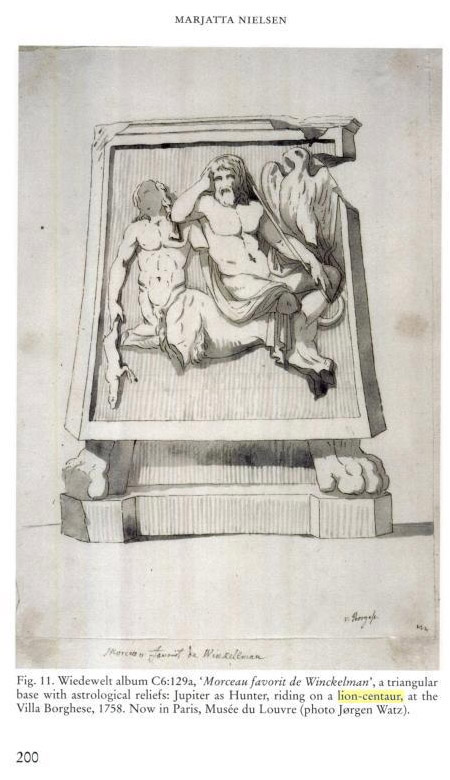For a while now, I've known about (and written about) lion-centaurs that appear in ancient Assyrian art. Now, thanks to the marvel of Google's effort to scan every book in existence, I've found a reference to lion centaurs in ancient Greek art. More on that later in this screed, but first I wanted to share with you a few links I just found relating to Assyrian wemics.
1) In this essay on Assyrian symbology, there is a very brief mention of lion-centaurs: "As for the rest of animal symbols, they are documented as following: Horse, horse's head, dog, cow & calf, turtle, snakes, scorpion, mongoose, fish, fly, walking bird, bird with back-turned head, bird on a low perch, long-neck bird standard, bird god, double lion-headed scepter, lion-headed staff, eagle-headed staff, ram-headed staff, goat-fish, Imdugud (bird-shaped), lion-centaur, bull of heaven, centaur, lion-dragon, lion-fish …"
2) In this glossary of Mesopotamian mythology, an entry on lion-centaurs says, "His figure was placed outside ablutions rooms, where he fended off the attacks of the leonine demon 'Mukil-res-lemutti’ or ‘Evil attendant’. "
3) In Alan Wall's 2003 novel, China, one character has a tattoo of a wemic. Here are two relevant passages from Google:
Digby had always wanted to ask about the tiny tattoo on the back of Desmond's neck. As far as he could make out it appeared to represent a lion, though this interpretation could have been disputed. The lion's head had somehow transmuted into an ancient fellow with a square beard, and the whiskers had come out as two thin waving arms. It struck Digby as a curious place to have a tattoo.
... and ...
'Do you mind if I ask you a question, Desmond? Something that's always intrigued me. What is the tattoo on the back of your neck?'
'A lion-centaur. It's a benevolent demon from Mesopotamia, Mr Wilton. Used to bar the way to all the forces of evil. The one on my neck's based on a stone relief from the royal palace of Assurbanipal.' Desmond pulled down his collar at this point and turned his back on Digby, thus enabling him to take a closer look.
4) The Museum of Fine Arts in Boston has put most of its vast collection online. One object on display is a horse blinder decorated with a winged lion-centaur chasing a flying sphinx. From the museum's online description:
Blinker from a horse harness
Near Eastern, Anatolian, Urartian
Iron Age
10th–9th century B.C.
Bronze
Height x width: 16.5 x 9.5 cm (6 1/2 x 3 3/4 in.)
Museum of Fine Arts, Boston
William Stevenson Smith Fund
1981.83
A winged lion-centaur at a flying gallop shoots a bow at a beardless sphinx with wings splayed and frontal face protruding in unusually high relief.
Provenance/Ownership History: By 1981: Phoenix gallery of Ancient Art; 1981: purchased from Phoenix Gallery of Ancient Art (Mr. and Mrs. R. Mele), 15 March 1981.
(Accession Date: April 15, 1981)
On view: Ancient Near East Gallery
And here is a detail from the work showing the flying lion-centaur:

5) And now let me show you my most recent find. Also from the Google book search, this is a page from a 2004 book, "The Rediscovery of Antiquity: The Role of the Artist," edited by Annette Rathje.

The text on the page spells it all out: "Jupiter as Hunter, riding on a lion-centaur, at the Villa Borghese, 1758. Now in Paris, Musee du Louvre."
This book is, of course, protected by copyright, and I am grateful to be able use this small excerpt for non-profit review purposes only. If you want to follow the link, you have to give Google your e-mail address.
This statue raises several questions. Was it created in 1758? By whom? Was a lion-centaur understood by the sculptor to be a part of Greek myth, or was it an addition by a relatively modern artist? If so, how did this artist get the idea of a wemic? Questions to be answered in a future screed.

